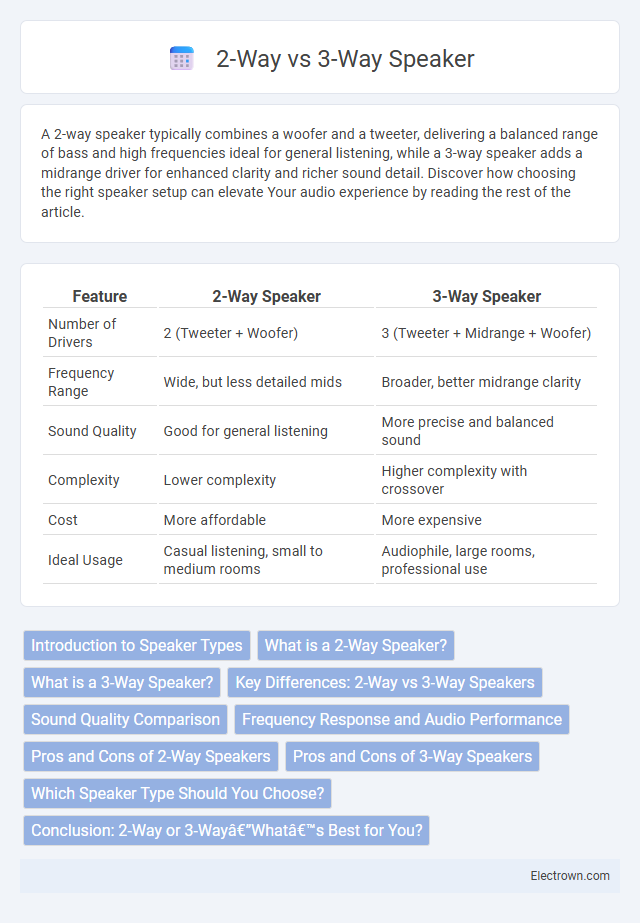A 2-way speaker typically combines a woofer and a tweeter, delivering a balanced range of bass and high frequencies ideal for general listening, while a 3-way speaker adds a midrange driver for enhanced clarity and richer sound detail. Discover how choosing the right speaker setup can elevate Your audio experience by reading the rest of the article.
Table of Comparison
| Feature | 2-Way Speaker | 3-Way Speaker |
|---|---|---|
| Number of Drivers | 2 (Tweeter + Woofer) | 3 (Tweeter + Midrange + Woofer) |
| Frequency Range | Wide, but less detailed mids | Broader, better midrange clarity |
| Sound Quality | Good for general listening | More precise and balanced sound |
| Complexity | Lower complexity | Higher complexity with crossover |
| Cost | More affordable | More expensive |
| Ideal Usage | Casual listening, small to medium rooms | Audiophile, large rooms, professional use |
Introduction to Speaker Types
2-way speakers typically contain a woofer and a tweeter, designed to handle low and high frequencies separately for clearer sound reproduction. 3-way speakers add a midrange driver, allowing finer frequency separation and more detailed audio performance across bass, midrange, and treble. Your choice depends on the desired sound clarity and complexity for listening environments.
What is a 2-Way Speaker?
A 2-way speaker consists of two drivers: a woofer for low and midrange frequencies, and a tweeter for high frequencies, providing a balanced sound profile with clear highs and solid bass. This design is efficient for delivering quality audio in compact setups, making it ideal for most home audio systems and portable devices. Your choice of a 2-way speaker ensures straightforward installation and versatile use with reliable sound performance.
What is a 3-Way Speaker?
A 3-way speaker features three distinct drivers: a woofer for low frequencies, a mid-range driver for mid frequencies, and a tweeter for high frequencies, enabling more precise sound reproduction across the audio spectrum. This separation allows the speaker to handle a wider range of audio signals with greater clarity and reduced distortion compared to 2-way speakers, which only have two drivers managing broader frequency ranges. Your listening experience benefits from enhanced detail and balanced sound, especially in complex musical compositions and dynamic soundtracks.
Key Differences: 2-Way vs 3-Way Speakers
2-way speakers feature two drivers--a woofer and a tweeter--dedicated to low-mid and high frequencies, delivering clear sound with simpler crossover design. 3-way speakers add a midrange driver, enhancing sound accuracy by dividing frequencies into low, mid, and high bands for richer and more detailed audio reproduction. Choosing between 2-way and 3-way speakers depends on your preference for audio precision versus system complexity and cost.
Sound Quality Comparison
Two-way speakers typically offer clear midrange and high frequencies by using a woofer and a tweeter, resulting in balanced sound for general listening. Three-way speakers include an additional midrange driver, which enhances sound quality by providing more precise frequency separation and richer detail in vocals and instruments. Your choice between the two depends on the desired audio clarity and depth, with three-way speakers delivering a more refined and immersive listening experience.
Frequency Response and Audio Performance
A 2-way speaker typically covers a frequency response range from around 60 Hz to 20 kHz using a woofer and a tweeter, providing clear mid and high frequencies but sometimes lacking deep bass. A 3-way speaker includes a woofer, midrange driver, and tweeter, allowing more precise handling of low, mid, and high frequencies, resulting in richer audio performance with enhanced clarity and deeper bass response. Your choice between these depends on whether you prioritize simplicity and cost efficiency or seek a fuller, more detailed sound experience.
Pros and Cons of 2-Way Speakers
2-way speakers typically offer a simpler design with a woofer and tweeter, delivering clear mid-range and high-frequency sound while being more affordable and easier to power. However, they may lack the full frequency range and detailed separation that 3-way speakers provide due to the absence of a dedicated midrange driver. Your choice depends on whether you prioritize straightforward setup and cost-effectiveness or more precise sound reproduction.
Pros and Cons of 3-Way Speakers
3-way speakers feature separate tweeter, midrange, and woofer drivers, offering enhanced sound clarity and a wider frequency range compared to 2-way speakers. They excel at producing distinct highs, mids, and lows, delivering a more detailed and balanced audio experience, but they tend to be more expensive and require precise crossover design to avoid phase issues. The complexity of 3-way speakers can lead to increased power consumption and larger cabinet size, which may not suit all listening environments.
Which Speaker Type Should You Choose?
Choosing between a 2-way and a 3-way speaker depends on your audio preferences and room acoustics. A 2-way speaker typically offers simplicity and clear sound separation with fewer components, making it ideal for smaller spaces or budget-conscious setups. In contrast, a 3-way speaker provides enhanced frequency response and greater detail by adding a dedicated midrange driver, benefiting larger rooms and audiophiles seeking richer, more accurate sound reproduction.
Conclusion: 2-Way or 3-Way—What’s Best for You?
Choosing between 2-way and 3-way speakers depends on your audio preferences and budget, as 2-way speakers offer simplicity and affordability with clear midrange and high frequencies, while 3-way speakers deliver enhanced sound separation and richer tonal depth by adding a dedicated midrange driver. If your priority is balanced sound quality for everyday listening without complexity, 2-way speakers might be the best fit. Your decision should align with your desired listening experience and system setup to maximize audio performance.
2-way vs 3-way speaker Infographic

 electrown.com
electrown.com